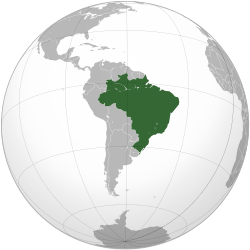
Back الجمهورية البرازيلية الرابعة Arabic İkinci Braziliya Respublikası Azerbaijani Втора република (Бразилия) Bulgarian República Nova Spanish Neljas Brasiilia Vabariik Estonian Quatrième République (Brésil) French הרפובליקה הרביעית של ברזיל HE Quarta Repubblica (Brasile) Italian ბრაზილიის მეორე რესპუბლიკა Georgian Den andre brasilianske republikk NB
You can help expand this article with text translated from the corresponding article in Portuguese. (September 2011) Click [show] for important translation instructions.
|
Republic of the United States of Brazil República dos Estados Unidos do Brasil | |||||||||
|---|---|---|---|---|---|---|---|---|---|
| 1946–1964 | |||||||||
Flag (1960)
| |||||||||
| Motto: "Ordem e Progresso" (English: "Order and Progress") | |||||||||
| Anthem: "Hino Nacional Brasileiro" (English: "Brazilian National Anthem") | |||||||||
 | |||||||||
| Capital | Rio de Janeiro (until 1960) Brasília (after 1960) | ||||||||
| Common languages | Portuguese | ||||||||
| Religion (1950)[1] |
| ||||||||
| Government | Federal presidential republic (1946–1961; 1963–1964) Federal parliamentary republic (1961–1963) | ||||||||
| President | |||||||||
• 1946–1951 (first) | Eurico Gaspar Dutra | ||||||||
• 1961–1964 (last) | João Goulart | ||||||||
| Prime Minister | |||||||||
• 1961–1962 | Tancredo Neves | ||||||||
• 1962 | Brochado da Rocha | ||||||||
• 1962–1963 | Hermes Lima | ||||||||
| Legislature | National Congress | ||||||||
| Senate | |||||||||
| Chamber of Deputies | |||||||||
| Historical era | Cold War | ||||||||
| 31 January 1946 | |||||||||
| 18 September 1946 | |||||||||
• Brasília as capital | 21 April 1960 | ||||||||
| 8 September 1961 | |||||||||
| 24 January 1963 | |||||||||
| 31 March 1964 | |||||||||
| Population | |||||||||
• 1950 | 51,944,397 | ||||||||
• 1960 | 70,992,343 | ||||||||
| Currency | Cruzeiro | ||||||||
| |||||||||
The Fourth Brazilian Republic, also known as the "Populist Republic" or as the "Republic of 46", is the period of Brazilian history between 1946 and 1964. It was marked by political instability and the military's pressure on civilian politicians which ended with the 1964 Brazilian coup d'état and the establishment of the Brazilian military dictatorship.
This period was marked by often tumultuous presidencies of Eurico Gaspar Dutra, Getúlio Vargas, Café Filho, Juscelino Kubitschek, Jânio Quadros and João Goulart. In 1945, president Getúlio Vargas was deposed by a bloodless military coup, but his influence in Brazilian politics remained until the end of the Fourth Republic. During this period, three parties dominated national politics. Two of them were pro-Vargas — the Brazilian Labour Party (Partido Trabalhista Brasileiro, PTB) to the left and the Social Democratic Party (Partido Social Democrático, PSD) in the center — and another anti-Vargas party, the rightist National Democratic Union (União Democrática Nacional, UDN).
- ^ "Religion in Latin America, Widespread Change in a Historically Catholic Region". Pew Research Center. 13 November 2014. Retrieved March 4, 2015.
© MMXXIII Rich X Search. We shall prevail. All rights reserved. Rich X Search

